
 |
| VOICES WEST: SEX IN THE WEST COWBOY-RELATED DOCUMENTS |
| Sex
in the West Bibliography: Sajna - Zorbaugh |
[Homepage] [Introduction] [Cowboy Poetry] [Cowboy Songs] [Postcards]
* Indicates from the collection of Alan V. Miller
* Sajna, Mike. Crazy Horse: the life behind the legend / Mike Sajna. New York: John Wiley and Sons, 2000. 367 p.
"Speculation about Crazy Horse's sexuality also might be fueled by the fact that he did not marry until after Hump had been killed and that among his friends as a boy was Woman's Dress, know in his youth as Pretty One ... Woman's Dress was a well-known winkte or homosexual." p.89.
 |
"Gee!" Gee!
But I'd like to |
Sarotte, Georges-Michel. Like a brother, like a lover: male homosexuality in the American novel and theatre from Herman Melville to James Baldwin / Georges-Michel Sarotte. New York: Anchor Press (Doubleday), 1978.
* Savage, William W, Jr. The cowboy hero: his image in American history and culture / William W. Savage. Norman, OK: University of Oklahoma Press, 1979. 179 p.
"The scarcity of women on the frontier of the historical cowboy and the preference of the fictive cowboy for male companionship have raised the specter of cowboy homosexuality in the minds of some observers. Others have suggested that the cowboy is a prime example not of homosexuality but of repressed heterosexuality, since heroics take precedence over the affairs of the heart, loins or whatever. There is much left to learn about cowboy sexuality, for few historians or novelists have dared to touch the subject." p.103-104.
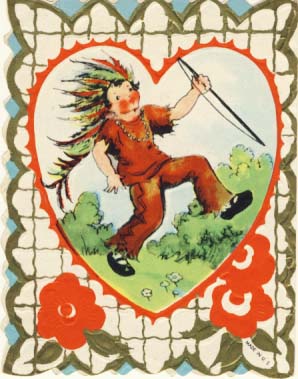 |
"Hands up! Hands up! |
* Savran, David. Communists, cowboys and queers: the politics of masculinity in the work of Arthur Miller and Tennessee Williams / David Savran. Minneapolis, MN: University of Minnesota Press, 1992. 204 p.
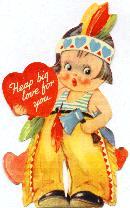 |
"Heap" Heap
big |
* Saxton, Alexander. The rise and fall of the white republic: class politics and mass culture in nineteenth-century America / Alexander Saxton. London [England]: Verso, 1990. 397 p.
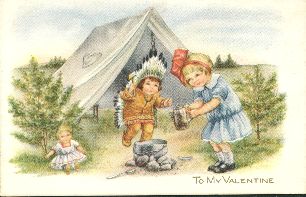 |
"To my valentine."
|
* Schlatter, Evelyn A. "Drag's a life: women, gender and cross-dressing in the nineteenth-century west." Ch.16, p.334-348. Writing the range: race, class, and culture in the women's West. Edited by Elizabeth Jameson & Susan Armitage. Norman, OK: University of Oklahoma Press, 1997.
"In 1887, the same issue of the [Denver] Times reported, Georgie, dressed as a man, attempted to rent a room with a female companion in a Denver building. The proprietor, however, was a detective who had arrested her several times in the past, and Georgie and companion quickly left the premises before he could do so again." p.339.
"The county has been rent from center to circumference during the last six weeks over the sensational love affair between Miss Clara Dietrich, postmistress and general storekeeper at Emma [Colorado] and Miss Ora Chatfield ... which culminated ... in the elopement of the two ladies who are now supposed to be stopping at a hotel in Denver" [Denver Times, July 6, 1889], p.339-340.
Schmidgall, Gary. Walt Whitman: a gay life / Gary Schmidgall. New York: Dutton, 1997. 428 p.
This books pulls together much that has been written on the homosexual life of Walt Whitman (1819-1892): "Several who have written on Whitman since the Stonewall uprising of 1969 have begun to show the way, and the time now seems ripe for a systematic attempt to turn the tables on the mythic, mist-engulfed Whitman and to set in his stead the flesh-and-blood -- which is to say the sexual -- Whitman." p.xxvii-xxix.
(See also Horace Traubel)
 |
"A valentine song." Listen
while |
* Scott, Gail R. Marsden Hartley. New York: Abbeville Press, 1988. 187 p. (See also Jonathan Weinberg.)
"Unlike Mabel Dodge, with her infatuation with the Indian mystique, and unlike the artists who used Indian subjects to paint another form of Americana, Hartley grew during his months in New Mexico to understand this native phenomenon at a deeper level, and in his writings was one of the first to champion it ... He attended nearly all the tribal dances in Taos and Santa Fe, but unlike John Sloan or Jan Matulka, he did not depict the dances in his painting. One, however, was the subject of a long poem, ‘The Festival of the Corn' (published in Poetry in 1920), which reflects Hartley's fascination with the intermingling of ancient Indian ceremonies and Catholic liturgical rituals." p.66.
"It was also with Arnold Ronnebeck, and his cousin, Karl von Freyburg [in Germany in 1917]... with this group that Hartley found the homosexual subculture." p.37.
Scott, John Anthony. The ballad of America: the history of the United States in song and story / John Anthony Scott. New York: Bantham Books, 1966.
* Seagraves. Anne. Soiled doves: prostitution in the early west. Hayden, ID: Wesanne Publications, 1994. 175 p.
 |
"Been a ridin' and a ropin' Made in the U.S.A. |
* Sears, Hal. The sex radicals: free love in high Victorian America / Hal Sears. Lawrence, KS: Regents Press of Kansas, 1977. 342 p.
"The letter remains significant as one of the few instances in nineteenth-century journalism of explicit discussion of oro- genital sex." p.111.
"He [Harman] served four months [of a five year sentence] before attorney Overmeyer won his release on a technicality. While free, he was tried for the O'Neill letter, found guilty, and sentenced to one year." p.112.
"A tragic lesbian scandal in 1892 sent shock waves through the ranks of the sex radicals and provided some indications of their feeling toward homosexuality. Two prominent and wealthy young Memphis ladies, Alice Mitchell and Freda Ward, planned to marry one another and to move away to St. Louis to live. Ward, who had been ardently courted by Mitchell, eventually attempted to call off the wedding, and in a fury, Mitchell slashed Ward's throat in broad daylight in front of the Memphis Custom House. The ensuing trial brought to light the correspondence of the two, the occurrence of transvestism, and the involvement of another girl." p.226.
"In an 1895 editorial [in the Lucifer], Lillian Harman assailed the treatment of [Oscar] Wilde by respectable society, particularly the wholesale quarantine of his literature by those who were afraid of becoming contaminated. She hardly approved of homosexuality, but she believed that there was slight danger of contacting it from his work." p.227.
Sears, James T. Lonely hunters: an oral history of lesbian and gay southern life, 1948-1968 / James T. Sears. New York: Eastview Press, 1997.
Out of the post-WWII period but much of interest.
 |
"To my dear one." To
my dear one. |
Seelye, John. "Introduction." In Owen Wister. The Virginian. New York: Penquin, 1988.
A sender of words: essays in memory of John G. Neihardt. Edited by Vine Deloria, Jr. Salt Lake City, UT; Chicago, IL: Howe Brothers, 1984. 177 p.
* Senelick, Laurence. "Boys and girls together: subcultural origins of glamour drag and male impersonation on the nineteenth- century stage." p.80-95. In Crossing the stage: controversies on cross-dressing. Edited by Lesley Ferris. London: Routledge, 1993.
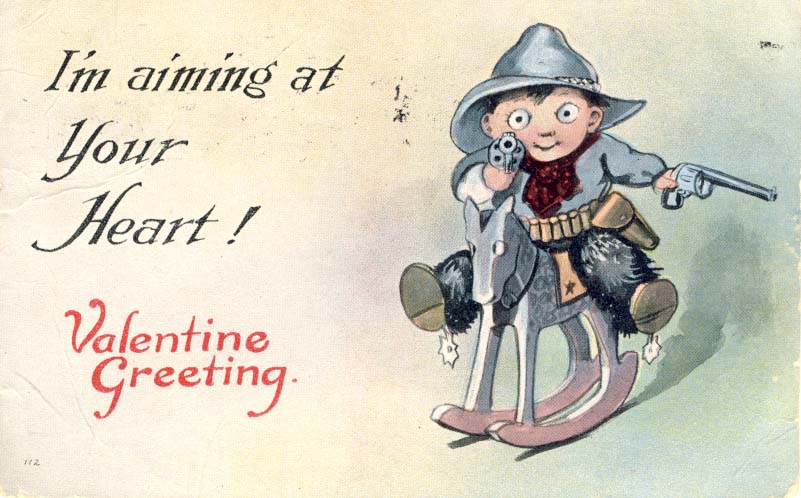 |
"I'm aiming at your heart! Valentine greeting."
|
* Shand-Tucci, Douglass. The crimson letter: Havard, homosexuality, and the shaping of American culture. New York: St Martin's Press, 2003. 403 p.
Mostly about life on the east coast of the United States, including chapters on Walt Whitman, Oscar Wilde and Lucien Price from Ohio. James Mills Peirce was "Professor X" in Sexual Inversion (1896) by Havelock Ellis. Also discussed is novel by Fred W. Loring, Two College Friends (1871); Loring was killed out west the same year.
* Sherrod, Drury. "The bonds of men: problems and possibilities in close male relationships." p.213-239. In The making of masculinities: the new men's studies. Boston, MA: Allen & Unwin, 1987. 346 p.
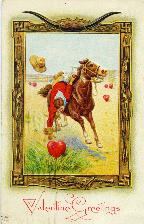 |
"Valentine greetings."
|
Shilts, Randy. Conduct unbecoming: gays and lesbians in the U.S. military, Vietnam to the Persian Gulf / Randy Shilts. New York: St. Martin's, 1993.
* Shively, Charley. Calamus lovers: Walt Whitman's working class camerados / Charley Shively. San Francisco, CA: Gay Sunshine Press, 1987.
* Shively, Charley. Drum beats: Walt Whitman's Civil War boy lovers / Charley Shively. San Francisco, CA: Gay Sunshine Press, 1989.
Side-saddle on the golden calf: social structure and popular culture in America. Edited by George H. Lewis. Pacific Palisades, CA: Goodyear Pub. Co., 1972. p.31.
* Signorile, Michelangelo. "The secret history of Mormons." Out (New York). 35: p.24-26, Aug. 1996.
Review of D. Michael Quinn Same-sex dynamics among nineteenth-century Americans.
 |
"Valentine greetings."
|
Sinfield, Alan. The Wilde century: effeminacy, Oscar Wilde and the queer moment / Alan Sinfield. New York: Columbia University Press, 1994. 216 p.
Siringo, Charles A. (1855-1928) A song companion of a lone star cowboy: old favorite cow-camp songs / Charles A. Siringo. Santa Fe, NM: C.A. Siringo, 1919.
* Slide, Anthony. Lost gay novels: a reference guide to fifty works from the first half of the twentieth century. New York: Harrington Park Press, 2003. See ch.9. "Myron Brinig: This Man is My Brother." Photocopies UT PS374.H63 S65 2003x
Brinig (1897-1991) grew up in Butte, MT, lived for a time in Taos, NM and knew Lynn Riggs and Cady Wells. His correspondence is filled with discussion of gay life in New York City.
 |
"I know a secret which I will tell: it's only for you, so listen well."
Wall, Series 6109 |
* Smith, Catherine; Greig, Cynthia. Women in pants: manly maidens, cowgirls and other renegades / Catherine Smith, Cynthia Greig. New York: Harry N. Abrams, 2003. 183pp.
See: "Romantic women: 'she was always fond of the ladies!'" p. 120-131
* Smith, Duane A. Rocky Mountain mining camps: the urban frontier / Duane A. Smith. Lincoln, NB: University of Nebraska Press, 1974, c1967. 304 p.
"Amid the companionship of his friends a man could relax, play cards, have a drink, sample from the free lunch counter, conduct business, or do well-nigh anything within reason that he desired. This stronghold of masculinity was seldom breached by the opposite sex." p.223.
* Smith, Henry Nash. Virgin land: the American West as symbol and myth / Henry Nash Smith. Cambridge, MA: Harvard University Press, 1950. 305 p.
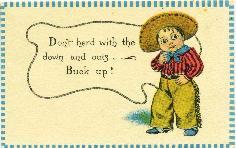 |
"Don't herd." Don't
herd with the |
* Smith-Rosenberg, Carroll. "Davy Crockett as trickster: pornography, liminality, and symbolic inversion in Victorian America." In Disorderly conduct: visions of gender in Victorian America. New York; Oxford : Oxford University Press, 1986, c1985. (See also Michael A. Lofaro)
" The animals in these episodes are almost always male and raise the issue of thinly veiled male homosexuality ... Along the Crockett frontier, male sexuality was violent, nonreproductive, usually nongential, and frequently homosexual." p.106.
 |
"I`m sure a lonely critter,
Wall, Series 6109 |
* Smith-Rosenberg, Carroll. "Davey [sic] Crockett as trickster: pornography, liminality, and symbolic inversion in Victorian America." Journal of comtemporary history. 17(2): 325-350, 1982.
* Smith-Rosenberg, Carroll. "The female world of love and ritual: relations between women in nineteenth-century America." p.411-435. In The American family in social -historical perspective. 3rd ed. Edited by Michael Gordon. New York: St. Martin's Press, 1983. (Originally published in Signs 1: 1-29, Autumn 1975)
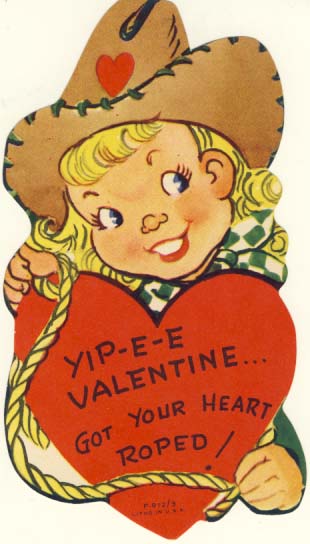 |
"Yip-e-e valentine." Got your heart roped! |
* Solomon, Deborah. "Gothic American." New York Times Book Review, Oct. 31, 2010, p.6-7. Review of R. Tripp Evans, Grant Wood: a life. New York: Alfred A. Knopf, 2010.
"A biography of an artist, typically, uses the details of a life to illuminate the work; Evans tests the reader's patience by using the work to bolster his theories about the artist's gay fantasies."
* Somerville, Siobhan B. Queering the color line: race and the invention of homosexuality in American culture / Siobhan B. Somerville. Durham, NC: Duke University Press, 2000.
"The early sexological model of inversion prevailed in the United States until the 1920s, when a notion of homosexuality as 'abnormal' sexual object choice began to emerge. By that time, Sigmund Freud's views on sexuality, which had been widely circulated since the 1910s, began to be popularized ... Freud viewed the debates about whether homosexuality was congenital or acquired as specious and instead argued that homosexuality played a part, to differing degrees, in everyone's sexuality." p.20.
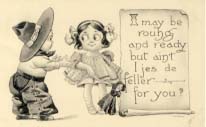 |
"I may be rouhg and ready but ain`t I jes de feller for you?"
Signed Wall |
* Sonstegard, Adam. "Performing the ‘unnatural' life: America's first gay autobiography." Biography. 25(4): 545-570, Fall 2002.
In 1901Claude Hartland published the first autobiography of an "invert" written in America. Sonstegard discusses the memoir's geographic context and its professional nature, using Hartland's access to the medical press of his day. He notes that Edward Prime-Stevenson had better access to the scientific discourse on the "uranian."
* Spring, Justin. Secret historian: the life and times of Samuel Steward, professor, tattoo artist, and sexual renegade. New York: Farrar, Straus and Giroux, 2010. 478 p.
Steward, also known as author Phil Andros, early in his teaching career (1934) taught at Carroll College in Helena, Montana, and the next year at the State College of Washington in Pullman.
"Academic and popular accounts of homosexual life during the 1940s, '50s, and early '60s have generally been accounts of marginalization, trauma, and victimhood. Tales of persecution and internalized self-loathing are rarely inspiring; but prejudice, persecution, blackmail, and social ostracism were, in fact, the essential conditions of an entire generation of homosexual men who lived through a period of sexual intolerance and social opprobrium that is barely imaginable today." p.410
* Stauffer, Helen. "Neihardt's journey on the Missouri." In A sender of words: essays in memory of John G. Neihardt. Edited by Vine Deloria, Jr. Salt Lake City, UT; Chicago, IL: Howe Brothers, 1984. 177 p.
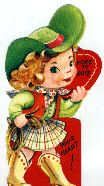 |
"I hope to rope." I
hope to rope |
* Stearns, Peter N. Be a man! Males in modern society / Peter N. Stearns. New York: Holmes & Meier Pub., 1979. 230 p.
"Homosexuality, increasingly shorn of religious proscription, became a mental illness; there was little relaxation against it in community custom. Hostility toward men who opted to become poets or artists increased, though a larger number of men could now choose these roles. In middle-class tirades against bohemianism, a host of male anxieties were expressed: envy of men who did not seem to accept a full, manly responsibility for proper breadwinning; concern that one's sons, in an age when paternal authority seemed to count for less, might slip away toward essentially feminine roles; a concern that manhood itself might be eroded if beauty or sensuality replaced tough realism. In its relaxation of community controls, the nineteenth century provided more outlets in fact for diverse male behavior than had been possible for the general run of men in preindustrial society." p.50.
"In the actual West, women might rough it along with the men, and even in imagery the Calamity Jane motif, the woman who could outman men, had some popularity. Real men and women might view their Western venture as almost a partnership ... But to many pioneers and to the larger number who merely read of the West, in Europe as well as the United States, the frontier seemed to write large the differences that seemed apparent even in more normal life between men and women." p.52
* Stein, Marc. City of sisterly and brotherly loves: lesbian and gay Philadelphia, 1945-1972 / Marc Stein. Chicago, IL: University of Chicago Press, 2000. 457 p.
One of the influential books on lesbian/gay history, although it covers material more recent than the pre-WWII period.
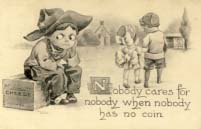 |
"Nobody cares for nobody when noboy has no coin."
Signed Wall |
Stevenson, Edward I. Prime see Mayne, Xavier
Stroven, Carl G. A life of Charles Warren Stoddard / Carl G. Stroven. Dissertation, Duke University, 1932. (See also John W. Crowley and Roger Austin)
Charles Warren Stoddard (1843-1909), homosexual author of South-sea idyls, 1892.
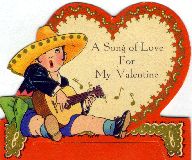 |
"A song of love." A
song of love |
Summers, Claude J. Gay fiction: Wilde to Stonewall: studies in male homosexual literary tradition / Claude J. Summers. New York: Continuum, 1990. 245 p.
* Taft, Michael. "Men in women's clothes: theatrical transvestites on the Canadian prairie." p.131-138. In Undisciplined women: tradition and culture in Canada. Edited by Pauline Greenhill and Diane Tye. Montreal, QC; Kingston, ON: McGill-Queen's University Press, 1997. 306 p.
"Some might take the Freudian tack that 'the human being oscillates all through his [sic] life between heterosexual and homosexual feelings' ... Freud was concerned with 'pathological' transvestism, rather than theatrical cross dressing, and while this ying-yang theory of human sexuality has its allure, it doesn't get us very far in understanding the more specific motivations of the farmer dressed as a bride." p.136.
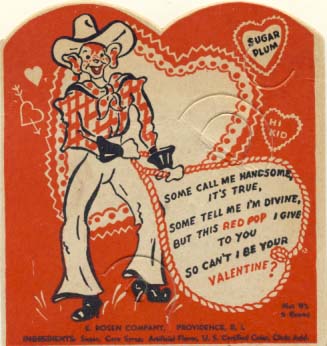 |
"Sugar Plum: Hi kid." Some call me handsome, |
Taylor, Mark A. Sandstone sunsets: in search of Everett Ruess / Mark A. Taylor. Salt Lake City, UT: Gibbs Smith, 1997. 116 p.
Deals tangentially with the disappearance of Everett Ruess, a 20-year old artist, and makes this conjecture: "Though Emery Kolb [a famous photographer who lived on the south rim of the Grand Canyon] was married and had a daughter, he spent most of the time with men and often engaged in dangerous stunts to prove his manhood. There is no evidence that he was gay, yet the possibility is worthy of exploration. Could it be that Kolb was attracted to the young artistic Ruess? Further, after Kolb was rebuffed by Everett, could a violent struggle have ensued during which Everett was shot?" Taylor believes that a skeleton found in Kolb's boat, after his death, could have been that of Everett Ruess. p.93
* Taylor, Verta; Kaminski, Elizabeth; Dugan, Kimberly. "From the Bowery to the Castro: communities, identities and movements." p.99-114. In Handbook of lesbian and gay studies. Edited by Diane Richardson and Steven Seidman. London: Sage Pub., 2002. 472 p.
"Looking at studies that have examined a range of communities over the course of the twentieth century, nevertheless we can see some common elements. First, communities are characterized by shared identities based on same-sex love and desire, although the names for and understandings of those identities change over time and from place to place. Second, communities are defined by distinct physical space - such as parks, neighborhoods, bars, bookstores, or coffeehouses - in which people gather. Third, commuities are built around social networks, institutions, or events. And, fourth, communities are marked by common cultural ideas and practices,including behavior, attire, and language that stand as markers of identity." p.100.
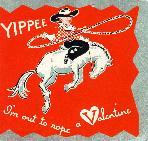 |
"Yippee." Yippee
|
* Terry, Jennifer. "Anxious slippages between 'us' and 'them': a brief history of the scientific search for homosexual bodies." p.129-169. In Bodies: critical perspectives on difference in science and popular culture. Edited by Jennifer Terry and Jacqueline Urla. Bloomington, IN: Indiana University Press, 1995. 416 p.
* Terry, Jennifer. "Lesbians under the medical gaze: scientists search for remarkable differences." Journal of sex research. 27(3): 317-339, August 1990.
Tompkins, Jane P. West of everything. London: Oxford University Press, 1992.
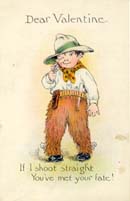 |
"Dear Valentine: if I shoot straight, you've met your fate!"
|
* Thorp, Jack (N. Howard) (1867-1940). "Along the Rio Grande" Cowboy Jack Thorp's New Mexico / Jack Thorp. Edited by Peter White and Mary Ann White. Santa Fe, NM: Ancient City Press, 1988. 225 p.
Todd, Edgeley W. "The frontier epic: Frank Norris and John G. Neihardt." Western humanities review. 13: 40-45, [?151- 154], Winter 1959.
* Toll, Robert C. Blacking up: the minstrel show in nineteenth-century America / Robert C. Toll. New York: Oxford University Press, 1974. 310 p.
"Minstrel audiences could, however, look forward to beautiful female figures, though fully dressed, promenading across minstrel stages and even flirting with the audience. But these were only illusions created by the female impersonator, who emerged in the postwar [American Civil War] period as minstelsy's most important new specialty role." p.139. Toll mentioned the "wench" roles played by George Christy, and Francis Leon's sensational career, from about 1858-1882, as a female impersonator.
 |
"I'm wild, valentine." I'm
wild, valentine. |
* Toll, Robert C. "Social commentary in late-nineteenth-century white minstrelsy." p.86-109. In Inside the minstrel mask: readings in nineteenth-century blackface minstrelsy. Edited by Annemarie Bean, James V. Hatch and Brooks McNarama. Hanover, MA: Wesleyan University Press, 1996.
"But the most exotic native American, the Indian, who also first came to minstrels' attention in the antebellum years, interested them until about 1880." p.89.
* Traubel, Horace. Intimate with Walt: selections from Whitman's conversations with Horace Traubel, 1888-1892. Edited by Gary Schmidgall. Iowa City, IA: University of Iowa Press, 2001. 319 p.
"Ed Folsom, a leading Whitman scholar and longtime editor of the Walt Whitman Quarterly Review, has discovered in correspondence in the Library of Congress that Traubel seems to have had a passionate relationship with a man five years younger than himself. This person, Gustave Percival Wiksell, became a dentist residing in Boston and for many years presided over the Whitman Fellowship ... Folsom describes a 'heated correspondence spanning over five years (1899-1905)' in which 'Traubel and Wiksell poured out their love for each other, often expressing themselves in Whitman's Calamus terminology." p.xxix-xxx.
* Trexler, Richard C. Sex and conquest: gendered violence, political order, and the European conquest of the Americas / Richard C. Trexler. Ithaca, NY: Cornell University Press, 1995. 292 p.
See: ch.3 "The military and diplomatic berdache," ch.4 "The domestic berdache: becoming," ch.5 "The religious berdache."
"This book can study the relations between eros and power at the time of the conquests with a more or less free hand because the massive recent literature on homosexual behavior has often been in denial, uncomfortable with questions of power. Thus some scholars have been so determined to find adult same-age, consenting homosexual subcultures in medieval and early modern European sources that they have denied that homosexual behavior involving power could even be called 'homosexuality.' Instead, it was 'pederasty.' Perhaps perversely, however, this book avoids using the word 'homosexuals' or 'homosexuality' altogether, because we now know that, while power certainly existed in this age, 'homosexuality' and 'homosexuals' in the modern sense did not." p.5-6
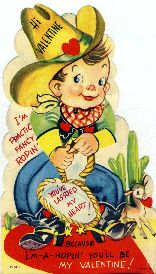 |
"Hi valentine." Hi
valentine. U.S.A.: np, [195-] 0-741/1 |
* Tripp, C.A. The intimate world of Abraham Lincoln. Edited by Lewis Gannett; introduction by Jean Baker. New York: Free Press, 2005. 343 p.
On Lincoln's same-sex attractions including his early friendship with Joshua Speed.
* Ullman, Sharon R. Sex seen: the emergence of modern sexuality in America / Sharon Ullman. Berkeley, CA: University of California Press, 1997. 176 p.
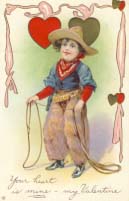 |
"Your heart is mine - my Valentine."
Series 313 B |
Van Allen, Elizabeth J. James Whitcomb Riley : a life / Elizabeth J. Van Allen. Bloomington, IN: Indiana University Press, 1999. 352 p.
Despite his passion for Matthews, it would be dangerous to classify Riley as a homosexual. During the nineteenth century, overt displays of affection between people in this type of relationship were common. Gender roles had not yet solidified; and it was not necessarily scandalous for men to hug, kiss, sleep with and proclaim their love for on another." p.171.
* Vicinus, Martha. "They wonder to which sex I belong: the historical roots of modern lesbian identity." Feminist studies. 18(3): 467-497, Fall 1992.
 |
"I - 'in tent' to be your valentine!" |
* Visions of the West: art and artifacts from the private collections of J.P. Bryan, Torch Energy Advisors Incorporated and others. Edited by Melissa Baldridge with an introduction by Patricia Nelson Limerick. Salt Lake City, UT: Gibbs-Smith, 1999. 320 p.
Small reference in the chapter "The Black West," to Cathy Williams who "dressed as a man and, as 'William Cathy,' served for two years in the Buffalo Soldiers." p.186.
Walker, Don D. "Riders and reality: a philosophical problem in the historiography of the cattle trade." Western historical quarterly. 9: 163-179, April 1978.
Walker, Franklin. San Francisco's literary frontier / Franklin Walker. New York: Knopf, 1939. p.273.
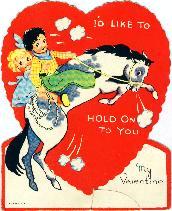 |
"I'd like to." I'd
like to |
Warner, Helen L. "Oscar Wilde's visit to Salt Lake City." Utah historical quarterly. 55: 333-334, Fall 1987.
* Weber, Eva. Ansel Adams and the photographers of the American West. North Dighton, MA: World Publication Group (JG Press), 2002. 255 p.
"One of [John K.] Hillers's most intriguing subjects was the Zuni berdache We'wha -- a man who led the life of a woman ... The fact that berdaches had an accepted and even important role, sometimes as shamans, in many North American Indian cultures was a difficult and even abhorrent concept for most nineteenth-century non-native Americans, who viewed these cultures through the filter of their own prejudices." p.104
See also one of sixty-two We'wha photographs by John K. Hillers: "We'wha, weaving a belt on a waist loom," 1879, p.129
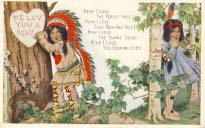 |
"Heap I love the forest free!"
Licht, The Pink of Perfection Series 1035 |
* Weeks, Jeffrey. Coming out: homosexual politics in Britain, from the nineteenth century to the present / Jeffrey Weeks. London: Quartet Books, 1979, c1977. 278 p.
See: "Definitions and self-definitions," p. 9-44; "Pioneers," p.45-83, on John Addington Symonds, Havelock Ellis and Edward Carpenter; and "Invisible women", p.85-111, especially on Radclyffe Hall.
* Weeks, Jeffrey. Sexuality and its discontents: meanings, myths and modern sexualities / Jeffrey Weeks. London: Routledge and Kegan Paul, 1985. 324 p.
See ch.4: "'Nature had nothing to do with it': the role of sexology," p.61-95. Weeks mentions Karl Ulrichs, Carl Westphal, Richard von Krafft-Ebing, Havelock Ellis, Magnus Hirschfeld, Sigmund Freud, Alfred Kinsey and others.
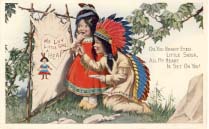 |
"Oh, you bright eyed little Sioux, All my heart is set on you!"
Licht, The Pink of Perfection Series 1035 |
Weeks, Jeffrey. " 'Sins and diseases': some notes on homosexuality in the nineteenth century." History workshop. 1: 211-219, Spring 1976.
* Weinberg, Jonathan. Intimacy and the creative pair / Jonathan Weinberg. Santa Fe, NM: Owings-Dewey Fine Art, 2001. 55 p.
"Charles Demuth and Marsden Hartley were roommates and traveling companions in Provincetown and Bermuda during the second decade of the twentieth century. Hartley remembered that Demuth had 'a quaint, incisive sort of wit with an ultra sophisticated, post eighteen-ninety touch to it.' He hinted at Demuth's homosexuality, alluding to his 'wistful comprehension of what many a too tender soul called infectious sin.' Hartley shared Demuth's attraction to men, but he tried to distance himself from what he perceived as his friend's effeminacy ... p.9.
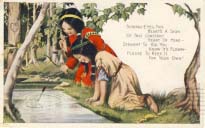 |
"Shining-eyes, this heart's a sign."
Licht, The Pink of Perfection Series 1035 |
* Weinberg, Jonathan. Speaking for vice: homosexuality in the art of Charles Demuth, Marsden Hartley and the first American avant-garde / Jonathan Weinberg. New Haven, CT; London: Yale University Press, 1993. 260 p.
"At the beginning of the twentieth century, hiding was certainly one of the dominant strategies of existence for homosexuals in America. The various stigmas against sexual difference in American society, the fear of physical violence, blackmail, and ostracism, produced behavior that various homosexual men shared despite differences in class, character, and education - a mode Edward Stevenson calls the 'Mask.' " p.157.
"[Hart] Crane committed suicide in the Gulf of Mexico in 1932; his death had an enormous effect on Hartley, but it is unclear how close the two poets were. Although they had met occasionally, it was only when they both received Guggenheim fellowships to work in Mexico that they saw each other regularly. Still, there is little indication in Hartley's letters that Crane meant much to him until after the poet's suicide ... Hartley hid his homosexuality from all but his closest friends, even writing disparagingly about homosexuals, as though he were not one of them. Whereas Hartley was relatively circumspect, Crane was often indiscreet." p. 163-165.
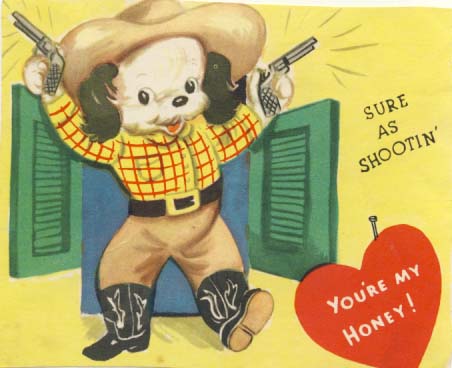 |
"Sure as shootin'." You're my honey! |
Weiss, Andrea; Shiller, Greta. Before Stonewall: the making of a gay and lesbian community / Andrea Weiss and Greta Shiller. Tallahassee, FL: Naiad, 1988.
* Westermeier, Clifford P. "The cowboy and sex." p.85-105. In The cowboy: six-shooters, songs and sex. Edited by Charles W. Harris and Buck Rainey. Norman, OK: University of Oklahoma Press, 1976. 167 p. (Reprint from Red River Valley historical review, Spring 1975.)
What was literature: class, culture and masculinity. New York: Simon and Schuster, 1982.
White, Richard. It's your misfortune and none of my own: a history of the American West / Richard. I. White. Norman, OK: University of Oklahoma Press, 1991. 644 p.
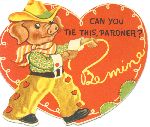 |
"Can you tie this, pardner?" |
Whitman, Walt. Democratic vistas / Walt Whitman. New York : J.S. Redfield ; Washington, DC : Sold by the author, 1871. (See also work by Charlie Shively and new work on Horace Traubel.)
Whitney, Blair. John G. Neihardt / Blair Whitney. Boston, MA: Twayne, 1976. 163 p.
Whitney writes: "The poet is discovering what Neihardt called 'cosmic consciousness' in which the individual fuses his soul with the transcendent All, with the Oversoul of Emerson and Whitman," p.51.
It was Richard M. Bucke, the Canadian biographer of Walt Whitman, who wrote the book Cosmic consciousness. To Bucke, Whitman was one of the few men who reached cosmic consciousness. Neihardt wrote a review, "Queerness," of L. Adams Beck's The openers of the gate, published in The St. Louis Dispatch, Sept. 8, 1930. Neihardt discusses Bucke's concept of "cosmic consciousness."
Whitney notes "Hugh ... has his humanity; and his sympathies are awakened by young Jamie, who is both son and innocent lover for the old man. Although The Song of Hugh Glass contains no overt homosexuality, the relationship between Jamie and Hugh has many parallels in classic American literature. In the wilderness, the sidekick replaces the hero's wife and offers another kind of love." p.110-111.
"But, unlike Mike Fink, Hugh Glass knows love; and that it is that love which leads him to forgiveness and transcendence." p.117.
 |
"Be mine." To play
my game requires aim |
Who's who in gay and lesbian history : from antiquity to World War II / edited by Robert Aldrich and Garry Wotherspoon. London ; New York : Routledge, 2001.
* Wilke, Jim. "Frontier comrades: homosexuality in the America West." p.164-172. In Out in all directions: the almanac of gay and lesbian America. Edited by Lynn Witt, Sherry Thomas and Eric Marcus. New York: Warner Books, 1995. 635 p.
* Wilke, Jim. "My lover is a cowboy." Out smart: Houston's gay and lesbian monthly magazine. February 1997, p.20-24,34.
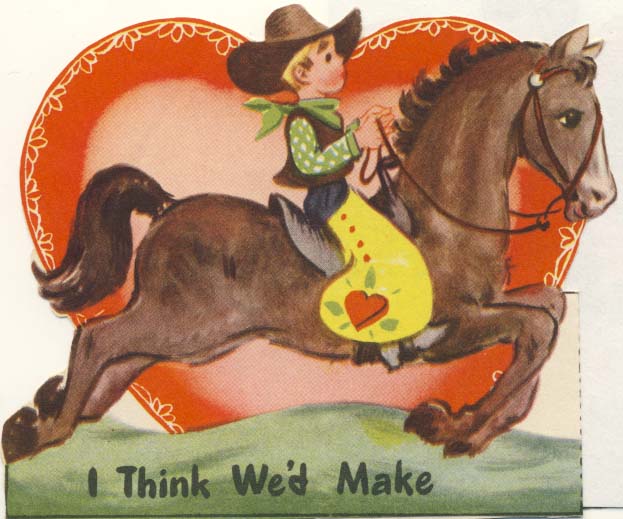 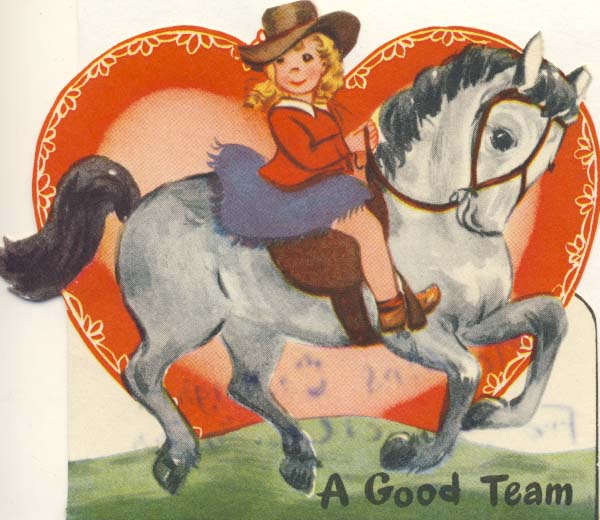 |
"How about it?" I think we'd make a good team. |
* Willet, Graham. Living out loud: a history of gay and lesbian activism in Australia / Graham Willett. Sydney ( St Leonards, N.S.W. ): Allen & Unwin, 2000. 307 p.
See chapter 1: "The scene and unseen: camp life in the 1950s," p.3-18.
* William Spratling and the Mexican silver renaissance: maestros de plata. Penny C. Morrill, with essays by Penny C. Morrill, John W. Scott, Helen Delpar, Adriana Williams, Gobi Stromberg, Jaime Castrejon Diez, Christie Romero, Patrick Kapty, Phyllis Goddard and Jill Crawford. New York: Harry N. Abrams ; in association with the San Antonio Museum of Art, 2002. 280 p. (See also biographies by W. Kenneth Holditch, Taylor D. Littleton and Joan Mark.)
Catalogue of an exhibition held at the San Antonio Museum of Art from Oct. 7, 2002, and other venues.
See: John W. Scott "William Spratling in New Orleans: the 1920s," p.71-96; see also reference to Hart Crane's poem "The broken tower," p.113, written in 1931 while in Taxco, Mexico. Crane was a quest of Spratling's.
"When asked about Spratling's personality, [Esther] Dupuy recalled that he was great fun but not a hell-raiser. A friend once told her that Spratling was homosexual." p.91
 |
"I won't 'squawk' if you'll be my valentine!" |
* Williams, Tennessee. Tennessee Williams memoirs / Tennessee Williams. New York: Doubleday, 1975. p.121-124
* Williams, Tennessee. Tennessee Williams' letters to Donald Windham, 1940-1965 / Tennessee Williams. Edited and with comments by Donald Windham. New York: Holt Rinehart and Winston, 1977, c1976.
 |
"My valentine." This
Rogers' stuff is keen in "pitchers" U.S.A.: np, [193-] |
* Williams, Walter L. The spirit and the flesh: sexual diversity in American Indian culture / Walter L. Williams. Boston, MA: Beacon Press, 1986. 344 p.
* Windham, Donald. Lost friendships / Donald Windham. New York: William Morrow, 1987, 1985, c1983.
Wister, Owen. The Virginian a horseman of the plains / Owen Wister. New York: Penquin, 1988.
Woodward, Kenneth L. "Bite the dust, Lone Range." Newsweek. April 7, 1975, p.90.
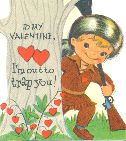 |
"To my valentine, I'm out to trap you." |
* Wrathall, John D. "Provenance as text: reading the silences around sexuality in manuscript collections." Journal of American history. 79(1): 165-178, June 1992.
* Writing the range : race, class, and culture in the women's West. Edited and with introductions by Elizabeth Jameson and Susan Armitage. Norman, OK: University of Oklahoma Press, c1997. 656 p.
Yacavone, Donald. "Abolitionists and the 'language of fraternal love'." p.85-95. In Meanings for manhood: constructions of masculinity in Victorian America. Edited by Mark C. Carnes and Clyde Griffen. Chicago, IL: University of Chicago Press, 1990. 274 p.
Yingling, Thomas. Hart Crane and the homosexual text: new thresholds, new anatomies / Thomas Yingling. Chicago, IL: University of Chicago Press, 1990. 271 p. (See also Taylor D. Littleton and Joan Mark)
Hart Crane, while in Mexico, met both Marsden Hartley and William Spratling.
 |
"Lucky
Strike bridge favors and place-cards." |
* Zinsser, William. Easy to remember: the great American songwriters and their songs / William Zinsser. Boston, MA : David R. Godine, 2000. 279 p.
See: "Duke Ellington (and Billy Strayhorn)," p.116-121. "Billy Strayhorn was everything Duke Ellington was not: small, shy, introspective, homosexual. But the two quickly fell into a composing relationship so symbiotic, the younger man habitually developing or completing Ellington's ideas, that nobody could tell - or knows to this day - who wrote what ... Strayhorn's role as Ellington's alter ego, muse and amanuensis - and as the sole composer of 'Lush life,' 'Chelsea bridge' and many other numbers associated with the band - ended only when he died in 1967, almost 30 years after the older man had let him in the door." p.119-120.
Zorbaugh, Harvey Warren. The Gold Coast and the slum / Harvey Warren Zorbaugh. Chicago, IL: University of Chicago Press, 1928.
[Sex in the West Introduction] [Contents] [Previous page]
 |
"Whereof the shining goal was comradeship." |
| Contact owner: Alan V. Miller at millera@cowboysong.com | |
| Last revised: February 8, 2013 |